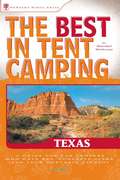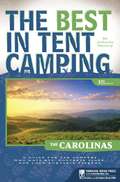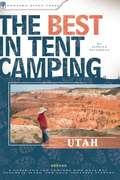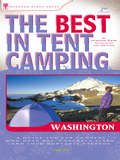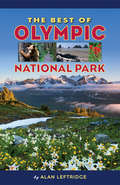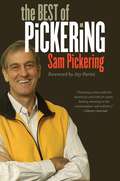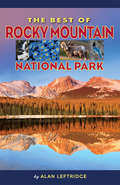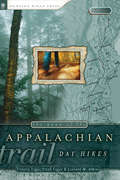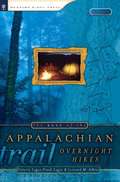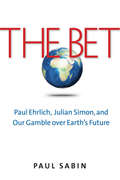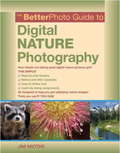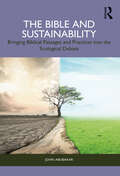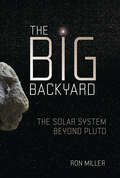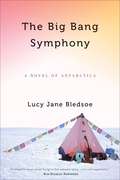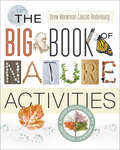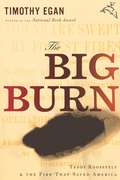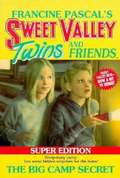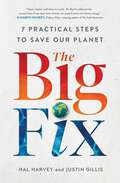- Table View
- List View
The Best in Tent Camping: Texas
by Wendel WithrowAs with all books in this series, the campgrounds selected for The Best in Tent Camping: Texas had to meet three criteria: they had to be accessible by car but not overrun with RVs; offer great scenery; and be as close as possible to a wilderness experience. Texas, with its extraordinary diversity of ecosystems, made author Wendel Withrow's search an exciting one. Divided into the state's major geographical areas, the book is based on the author's 30 years' experience in following the back roads of Texas. Along with a detailed profile and useful at-a-glance information, clear maps show campground layout, individual sites, and key facilities. Driving directions supplemented with GPS-based coordinates for each campground entrance make getting there a snap. Regional maps and a profile numbering system make the book easy to use and enjoy.
The Best in Tent Camping: The Carolinas
by Johnny MolloyWritten to steer campers away from concrete slabs and convoys of RVs, The Best in Tent Camping: The Carolinas is the only guide for tent camping in the state. Pointing tent campers to the most scenic and serene campsites in the Palmetto and Tar Heel States, this latest edition has a campground to suit nearly every camper's taste. In North Carolina, experience the rare spruce-fir forest of Balsam Mountain Campground or the sand dunes of Frisco Campground. Visit Cherry Hill, South Carolina's finest upcountry campground, or pitch a tent by the Atlantic Ocean in Hunting Island State Park. Travelers will find essential information about each campground (including season, facilities, rates, directions, GPS coordinates, and websites), as well as a description of the campground, the best sites, and nearby activities such as hiking, canoeing, fishing, and mountain biking.
The Best in Tent Camping: Utah
by Jeffrey SteadmanThe Best in Tent Camping: Utah is a tent camper's dream. From over 400 campgrounds statewide, the author has culled the 50 best places to pitch your tent and steer clear of those frantic and bustling campgrounds full of RVs, concrete slabs, and loud portable stereos. Most of the campgrounds included keep the tent camper in their element: away from the biggest crowds and in those quieter, special campgrounds that only the locals seem to know about.Each highlighted campground was carefully selected for its friendliness to the tent-camper as well as for what it offers campers in the surrounding area.Campgrounds included put the car camper in some of Utah's best and most beautiful backcountry; from the colorful sandstone canyons of southern Utah, to the thick woods of the Wasatch Mountains in the north. National parks, state parks, a desert reserve, and even an island host some of the fifty featured campgrounds.Each campground has been rated on six criteria:beauty, privacy, spaciousness, quiet, security and cleanliness. In addition, campground profiles include vital statistics about each location (fees, restrictions, operating season, amenities, contact information, driving directions and reservation information, to name a few) that help campers plan the perfect trip without unwanted surprises. GPS (Global Positioning Satellite) users will also appreciate that each campground's precise latitude and longitude waypoints are included.Tent campers will also enjoy a detailed map of each campground included in the site profile. Making reservations online or blindly over the phone can put a camper miles from the restroom, stranded with no shade, or in the middle of a busy campground trail. Maps will help campers avoid those pitfalls, and wherever possible the author has even recommended specific campsites for maximum privacy, spaciousness, or beauty.Although there's never a shortage for things to do in Utah's outdoors, campground summaries in the book also suggest attractions and activities near each campground. Fishing, hiking, biking, paddling, and scenic drives in the immediate area are recommended to ensure that campers know the basic lay of the land and have a jumping-off point to plan their trip.Whether it's a large family looking to get away for the weekend, a scout troop that wants to try something new, or a serious outdoors enthusiast searching for a place to adventure for the day and crash for the night, The Best in Tent Camping:Utah has done all the work in finding those special, out-of-the-way campgrounds, and gives campers the tools to plan an amazing, unforgettable camping trip.
The Best in Tent Camping: Washington
by Ian Devine Jeanne Louise PyleFrom the Olympic Peninsula to Puget Sound, the Emerald State offers a wealth of camping opportunities. This expert guide profiles 50 of the state's best campsites, using a handy star system to rank everything from beauty, privacy, and spaciousness to quiet, security, and cleanliness. Each site is accessible by automobile but not overrun by RVs, offers great scenery, and is as close to a wilderness experience as possible. Useful at-a-glance data covers reservations, fees, and restrictions. Clear maps show campground layout, individual sites, and key facilities. Driving directions supplemented with GPS-based coordinates for each site entrance make getting there a snap.
The Best of Olympic National Park
by Alan LeftridgeMake the most of your trip to Olympic National Park! From the coast to the rain forest to the snowcapped mountains, this handy guide covers all the best hikes, best picnic spots, best places to see wildlife, best wildflowers, best waterfalls, best activities for kids, and more. Compiled by a former park ranger, with beautiful color photographs, locator maps, and clear, concise directions.
The Best of Pickering
by Sam PickeringHis writing is as unique and recognizable as the music of Mozart, the painting of Picasso, or the poetry of Dickinson. Yet most Americans likely know Sam Pickering, the University of Connecticut English professor, from the movie Dead Poets Society. In the film, Robin Williams plays an idiosyncratic instructor---based on Pickering---who employs some over-the-top teaching methods to keep his subjects fresh and his students learning. Fewer probably know that Pickering is the author of more than 16 books and nearly 200 articles, or that he's inspired thousands of university students to think in new ways. And, while Williams may have captured Pickering's madcap classroom antics, he didn't uncover the other side of the author-Sam Pickering as one of our great American men of letters. The Best of Pickering amply demonstrates Pickering's amazing powers of perception, and gives us insight into the mind of a writer nearly obsessed with turning his back on the conventional trappings of American success-a writer who seems to prefer lying squirrel's-eye-level next to a bed of daffodils in the spring or trespassing on someone else's property to pursue a jaunt through joe-pye weed and goldenrod. Indeed, Pickering's philosophy, at least on paper, may very well be "Now is the only time." If you haven't met Sam Pickering before, prepare to be surprised and delighted by these wry and sometimes self-deprecating essays that are witty and elegant and concrete yet wander widely, and include Pickering's well-trod fictional Southern town of Carthage, Tennessee, full of strange goings-on. This definitive collection of the best of Pickering is a must for Pickering fans and a fine introduction for the uninitiated to one of our greatest men of letters.
The Best of Rocky Mountain National Park
by Alan LeftridgeMake the most of your trip to Rocky! This handy guide covers everything you need to know. Find the best hikes, best picnic spots, best places to watch wildlife, best wildflowers, best waterfalls, best activities for kids, and more. Compiled by a former park ranger, with beautiful color photographs, locator maps, and clear, concise directions.
The Best of Yellowstone National Park
by Alan LeftridgeThe Best of Yellowstone National Park reveals the best things to see and do in the world's first national park, from the best day hikes and scenic drives to the best places to see wildlife and wildflowers. Former National Park Service ranger Alan Leftridge guides the reader through all the superlatives Yellowstone has to offer, including sections on the best activities for kids and the best things to do on a rainy or snowy day. Where are the bears? Where can wolves be seen? Where are the best fishing spots? What are the must-see historic sites? Where are the best waterfalls? This handy guide has all the answers. Amply illustrated with 195 color photographs and 15 locator maps, The Best of Yellowstone National Park should be in every visitor's backpack and within easy reach on the dashboard.
The Best of the Appalachian Trail: Day Hikes
by Frank Logue Victoria Logue Leonard AdkinsYou love to backpack, but you can only get out on the trail a few weekends a year. This book was written for you. It is the first guide to cover the length of the Appalachian Trail in a single volume. It doesn't describe every mile of the trail, but offers detailed descriptions of the suggested hikes. Why sort through guidebooks looking for a good hike, when the best of the Appalachian Trail is all here in one book. Includes day hikes in all fourteen states the Appalachian Trail passes through.
The Best of the Appalachian Trail: Overnight Hikes
by Frank Logue Victoria Logue Leonard AdkinsOvernight hikes in all fourteen states the Appalachian Trail passes through are described in brief, followed by a point-by-point description of the hike and trailhead directions.
The Bet
by Paul SabinIn 1980, the iconoclastic economist Julian Simon challenged celebrity biologist Paul Ehrlich to a bet. Their wager on the future prices of five metals captured the publics imagination as a test of coming prosperity or doom. Ehrlich, author of the landmark book "The Population Bomb, " predicted that rising populations would cause overconsumption, resource scarcity, and famine--with apocalyptic consequences for humanity. Simon optimistically countered that human welfare would flourish thanks to flexible markets, technological change, and our collective ingenuity. Simon and Ehrlichs debate reflected a deepening national conflict over the future of the planet. "The Bet" weaves the two mens lives and ideas together with the eras partisan political clashes over the environment and the role of government. In a lively narrative leading from the dawning environmentalism of the 1960s through the pivotal presidential contest between Jimmy Carter and Ronald Reagan and on into the 1990s, Paul Sabin shows how the fight between Ehrlich and Simon--between environmental fears and free-market confidence--helped create the gulf separating environmentalists and their critics today. Drawing insights from both sides, Sabin argues for using social values, rather than economic or biological absolutes, to guide societys crucial choices relating to climate change, the planets health, and our own.
The BetterPhoto Guide to Digital Nature Photography
by Jim MiotkeFrom the tiniest ladybug to a towering glacier, from a horse running in a field to a leaf falling slowly from a tree, nature subjects offer some of the greatest challenges and the greatest rewards to photographers. In the BetterPhoto tradition, here's a complete photo course in a book. Hands-on lessons cover every aspect of digital nature photography, from buying the right camera for close-ups, landscapes, and movement, to understanding how the camera works, to taking great pictures. Author Jim Miotke uses straightforward text and inspiring yet informative photos to show the best ways to approach nature photography. Everything a beginner or intermediate photographer needs to know is here, including a buyer's guide, full information on camera features, file formats and settings, exposure, low-light photography, filters and white balance, composition and lens choice, creative ideas, manipulating, and printing, along with a glossary and list of useful websites. The Better Photo Guide to Digital Nature Photography helps photographers everywhere get great photos in the great outdoors.From the Trade Paperback edition.
The Bible and Sustainability: Bringing Biblical Passages and Practices into the Ecological Debate
by John AbubakarThe Bible and Sustainability addresses the ecological crisis the world is facing, and what the Bible can teach us about sustainable living. Drawing on the interest in the ecological debate generated by Laudato Si, this book attempts to push the discussion beyond intellectual perspectives and help students and researchers apply biblical wisdom to the UN sustainable development goals.It begins with a discussion of what sustainability is, and how people, planet, and profit are affected by unsustainable practices, before exploring four specific biblical practices and their relationship with sustainability: Covenants, the sabbatical year, monastic communities, and the fruit of the spirit. It also discusses the creation account and personalistic nature texts, considering the social relationship that humans have with nature. Finally, it examines an Augustinian perspective on sustainability which encourages sharing, common ownership of property, and living simply. The book concludes by inviting governments, civil society organizations, and academia to bring these biblical practices and passages into the ecological debate.It is an outstanding resource for researchers of the Bible and environment, and Religion and environment more generally.
The Big Backyard: The Solar System beyond Pluto
by Ron MillerThousands of years ago, humans believed that Earth was the center of the universe, that the world they lived on was all there was. Truthfully, the solar system extends almost halfway to the nearest star. And it is composed of not only planets, asteroids, and comets, but also powerful forces and vast fields of energy. This is our solar system’s big backyard. The cold, dark world that lies at the farthest reaches of our solar system holds a vast collection of secrets, and for most of human history, we had no idea anything was out there. But, driven by curiosity and equipped with new technology, astronomers have determined that beyond the orbit of Neptune are countless icy comets, strange particles that dance under the influence of the sun, and signs of undiscovered planets. To learn more about these far-flung objects, scientists have finally begun to explore the distant solar system, finding answers to age-old questions at the same time that they encounter new mysteries. With Ron Miller’s incredible illustrations and photographs from NASA probes and telescopes, The Big Backyard takes us on a tour through the solar system’s most obscure neighborhoods and into its darkest corners, to places beyond the limits of the human eye. Miller expertly describes the formation of the solar system and the history of the exploration of the outer solar system before delving into the latest discoveries and missions. Read on to learn what sorts of objects orbit at such extreme distances, what happens at the boundary between the sun’s influence and interstellar space, whether there is such a thing as the mysterious Planet X, and how life on Earth could not exist without the happenings at the edge of the solar system.
The Big Bang Symphony: A Novel of Antarctica
by Lucy Jane BledsoeAntarctica is a vortex that draws you back, season after season. The place is so raw and pure, all seal hide and crystalline iceberg. The fishbowl communities at McMurdo Station, South Pole Station, and in the remote field camps intensify relationships, jack all emotion up to a 10. The trick is to get what you need and then get out fast. At least that's how thirty-year-old Rosie Moore views it as she flies in for her third season on the Ice. She plans to avoid all entanglements, romantic and otherwise, and do her work as a galley cook. But when her flight crash-lands, so do all her plans. Mikala Wilbo, a brilliant young composer whose heart--and music--have been frozen since the death of her partner, is also on that flight. She has come to the Ice as an artist-in-residence, to write music, but also to secretly check out the astrophysicist father she has never met. Arriving a few weeks later, Alice Neilson, a graduate student in geology who thinks in charts and equations, is thrilled to leave her dependent mother and begin her career at last. But from the start she is aware that her post-doc advisor, with whom she will work in Antarctica, expects much more from their relationship. As the three women become increasingly involved in each other's lives, they find themselves deeply transformed by their time on the Ice. Each falls in love. Each faces challenges she never thought she would meet. And ultimately, each finds redemption in a depth and quality of friendship that only the harsh beauty of Antarctica can engender. Finalist, Lambda Literary Awards Finalist, Ferro-Grumley Award for LGBT Fiction, awarded by the Publishing Triangle Finalist, Northern California Independent Booksellers Association Honorable Mention, Foreword Magazine's Gay/Lesbian Fiction Book of the Year Best Books for General Audiences, selected by the Public Library Association
The Big Book of Nature Activities: A Year-Round Guide to Outdoor Learning
by Jacob Rodenburg Drew MonkmanThe average child can identify over one thousand corporate logos, but only ten native plants or animals--a telling indictment of our modern disconnection from nature. Soaring levels of obesity, high rates of ADHD, feelings of stress and social awkwardness, and "Nature Deficit Disorder" are further unintended consequences of a childhood spent primarily indoors.The Big Book of Nature Activities is a comprehensive guide for parents and educators to help youth of all ages explore, appreciate and connect with the natural world. This rich, fully illustrated compendium features: Nature-based skills and activities such as species identification, photography, journaling, and the judicious use of digital technology Ideas, games, and activities grounded in what's happening in nature each season Core concepts that promote environmental literacy, such as climate change and the mechanisms and wonder of evolution, explained using a child-friendly, engaging approach Lists of key species and happenings to observe throughout the year across most of North AmericaPerfect for families, educators, and youth leaders , The Big Book of Nature Activities is packed with crafts, stories, information and inspiration to make outdoor learning fun.Jacob Rodenburg is the Executive Director of the Camp Kawartha summer camp and outdoor education centre. As well as publishing numerous articles on children, nature and the environment, he has worked in the field of outdoor education for twenty-five years.Drew Monkman is an award-winning environmental advocate, naturalist, and retired teacher. In addition to his weekly nature column, Drew is the author of two season-based nature guides, including Nature's Year.
The Big Book of Wooden Boat Restoration: Basic Techniques, Maintenance, and Repair
by Thomas LarssonAn excellent manual for embarking on a wooden boat restoration project.The Big Book of Wooden Boat Restoration is the perfect introduction or reference guide for both novice and experienced wooden boat enthusiasts. Author Thomas Larsson, one of Sweden’s most experienced and premier wooden boat restorers, has compiled his knowledge of the craft for readers and placed it in this book. This ultimate guide to restoration contains useful facts and an extensive glossary, accessible to both new hobbyists and longtime boat lovers.Also within this book are chapters on boat care, including winter maintenance, racing, finishing, and stripping. Additionally, there is updated information on boat building, gluing, and tools. The most extensive part of this book consists of chapters that describe the detailed clean repair of wooden boats-everything from plug accession and bonding to changing socks and bottom engine installation.Larsson includes a history of boat building and provides a nice glimpse of different wooden boats with more than two hundred sketches and photos in both color and black-and-white. He explains how staying on top of maintenance keeps a unique fleet of wooden boats alive. With practical instructions and fact boxes with advice and tips, this book will teach you all about maintenance: surface treatment, scraping the hull, equipping the boat in the spring, and looking after it in the winter. Also included are tips on buying a boat, installing an engine, and more.Skyhorse Publishing, as well as our Sports Publishing imprint, is proud to publish a broad range of books for readers interested in sports-books about baseball, pro football, college football, pro and college basketball, hockey, or soccer, we have a book about your sport or your team.In addition to books on popular team sports, we also publish books for a wide variety of athletes, including books on running, cycling, horseback riding, swimming, tennis, martial arts, golf, camping, hiking, aviation, boating, and so much more. While not every title we publish becomes a New York Times bestseller or a national bestseller, we are committed to publishing books on subjects that are sometimes overlooked by other publishers and to authors whose work might not otherwise find a home.
The Big Burn
by Jeanette IngoldWinner of the Western Writers of America Spur Award for Teen Fiction from the author of Hitch and Paper Daughter. “A must-read for adrenaline junkies.”—VOYAOn a hot summer day in 1910 a teenage soldier assembled his rifle. A girl argued to save trees on a mountain homestead. A young man set out to fight fire. None knew that soon the many blazes burning across northern Idaho would blow up and send a wall of flame racing their way.Portraying a natural disaster that would dictate how the United States would fight wildfire in the 20th century, The Big Burn brings to life a turning point in fire science, forestry, and history. Richly drawn characters doing their best against gigantic odds will grip your heart. The realistic depiction of wildfire will make you feel you were there.With non-fiction Field Notes and an Afterword about firefighting today, it’s a novel that moves from the 1900s into the 21st century. Whether you’re an adult or young adult reader, you’ll come away with a new understanding of nature and a “heighten[ed] appreciation for the courage and sacrifice of firefighters and settlers” (Publishers Weekly).Montana Book Award Honor“Historically accurate and dramatically engaging.”—Teen Reads“Presents a vivid picture of a natural disaster while skillfully conveying in fluid prose the individual stories of the three young people.”—Horn Book“Fascinating and harrowing . . . for any kid whose tastes run to disaster and survival, mixed into a coming of age story.”—Richie’s Picks“A solid adventure story with a well-realized setting.”—Booklist
The Big Burn: Teddy Roosevelt and the Fire that Saved America (Playaway Adult Nonfiction Ser.)
by Timothy EganNational Book Award-winner Timothy Egan turns his historian's eye to the largest-ever forest fire in America and offers an epic, cautionary tale for our time. On the afternoon of August 20, 1910, a battering ram of wind moved through the drought-stricken national forests of Washington, Idaho, and Montana, whipping the hundreds of small blazes burning across the forest floor into a roaring inferno that jumped from treetop to ridge as it raged, destroying towns and timber in the blink of an eye. Forest rangers had assembled nearly ten thousand men to fight the fires, but no living person had seen anything like those flames, and neither the rangers nor anyone else knew how to subdue them. Egan recreates the struggles of the overmatched rangers against the implacable fire with unstoppable dramatic force, and the larger story of outsized president Teddy Roosevelt and his chief forester, Gifford Pinchot, that follows is equally resonant. Pioneering the notion of conservation, Roosevelt and Pinchot did nothing less than create the idea of public land as our national treasure, owned by every citizen. Even as TR's national forests were smoldering they were saved: The heroism shown by his rangers turned public opinion permanently in favor of the forests, though it changed the mission of the forest service in ways we can still witness today.
The Big Camp Secret (Sweet Valley Twins Super Editions #3)
by Jamie Suzanne Francine PascalGirls, boys, and ghosts ... Identical twins Jessica and Elizabeth Wakefield can't believe they're finally at sleep-away camp. Even though there are no boys, and Elizabeth's friend Grace had to cancel her plans to go at the last minute, it may be two whole weeks of fun, fun, fun! The twins waste no time diving into their favorite activities. Jessica begins to arrange a rendezvous with the boys' camp across the lake. Elizabeth spends much of her time horseback riding and making new friends. But the real excitement starts when Grace turns up in the most unexpected place. Should the twins take a chance and hide Grace? If they do and they're caught, camp may just turn out to be the worst two weeks of their lives!
The Big Empty: Contemporary Nebraska Nonfiction Writers
by Ladette Randolph Nina Shevchuk-MurrayExploring the State of Nebraska from its rural reaches to its urban engines, from its marvelous ecosystems to its myriad historical and cultural offerings, these narratives evoke Nebraska in all its facets.
The Big Fix: Seven Practical Steps to Save Our Planet
by Hal Harvey Justin GillisAn engaging, accessible citizen&’s guide to the seven urgent changes that will really make a difference for our climate—and how we can hold our governments accountable for putting these plans into action.Dozens of kids in Montgomery County, Maryland, agitated until their school board committed to electric school buses. Mothers in Colorado turned up in front of an obscure state panel to fight for clean air. If you think the only thing you can do to combat climate change is to install a smart thermostat or cook plant-based burgers, you&’re thinking too small. That&’s where The Big Fix comes in, offering everyday citizens a guide to the seven essential changes our communities must enact to bring our greenhouse gas emissions down to zero—and sharing stories of people who are making those changes reality. Energy policy advisor Hal Harvey and longtime New York Times reporter Justin Gillis hone in on the seven areas where ambitious but eminently practical changes will have the greatest effect: electricity production, transportation, buildings, industry, urbanization, use of land, and investment in promising new green technologies. In a lively, jargon-free style, the pair illuminate how our political economy really works, revealing who decides everything from what kind of power plants to build to how efficient cars must be before they&’re allowed on the road to how much insulation a new house requires—and how we can insert ourselves into all these decisions to ensure that the most climate-conscious choices are being made. At once pragmatic and inspiring, The Big Fix is an indispensable action plan for citizens looking to drive our country&’s greenhouse gas emissions down to zero—and save our climate.
The Big Game of Everyhting
by Chris LynchYou have to love your family. You do, even if you don't, right? You don't have to understand them or play tennis with them, but you have to love them. It's a rule, and it's the kind of rule you don't break unless you're some kind of animal. My brother happens to be some kind of animal. My sister rides this sweet gold Honda scooter and has amazing hair. You'd hate her. My parents are vegetarian let-the-sunshine-in freaks. Lovable freaks but freaks all the same. My grandfather possesses a shocking comb-over, a kilt, about half of his original marbles, and his own golf complex. This summer, we are all working for him. It is going to be two hot, lucrative, carefree months of paradise. Or, possibly something else.
The Big Muskie (Wilderness Ridge)
by Thomas Kingsley TroupeWes has never been fishing. He doesn’t even like eating fish! So when his best friend, Josh, invites him on a fishing trip to his family’s cabin, Wes isn’t too excited. But then Josh’s dad tells a story about catching a gigantic muskie. Soon Wes is hooked. He starts to enjoy fishing—and even eating fish. But he can’t stop thinking about what it would be like to hook a big muskie. Will his curiosity lead to a big catch?
The Big One: The Cascadia Earthquakes and the Science of Saving Lives (Scientists in the Field Series)
by Elizabeth RuschNo one ever thought the Pacific Northwest was due for an earthquake, let alone a catastrophic one. But geologists are transforming our understanding of the grave dangers the population in the region of Cascadia face—will there be a big one? And what can be done to save lives? America's Pacific Northwest has relatively few earthquakes—only a handful each year that cause even moderately noticeable shaking. But a couple decades ago, scientists discovered a geological feature running along the coast that in other parts of the world regularly triggers massive earthquakes of 8.0 magnitude and higher. Were there once massive earthquakes in this part of the world? Geologists think there were. Now a small group of scientists are studying things that you might not think have anything to do with earthquakes—marsh soil, ocean sediments, landslide debris, and ghost forests—and they have reason to believe that the Pacific Northwest is likely not as idyllic as it was once assumed. The population is likely in grave danger of a massive earthquake at some point. What can be done? The big one can't be stopped, but scientists are working tirelessly to learn as much as they can to prepare.
